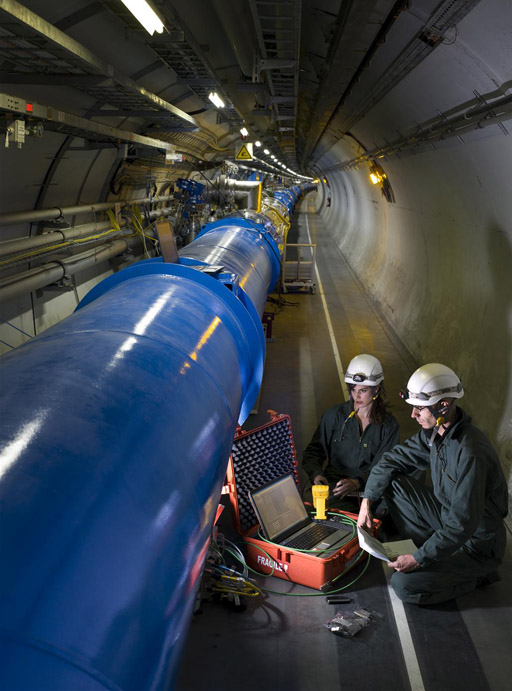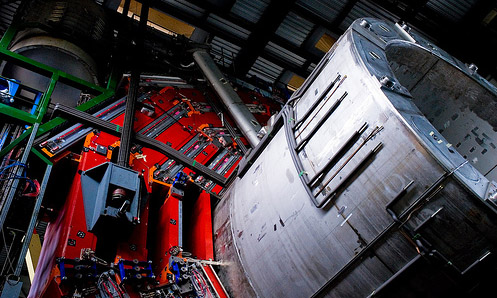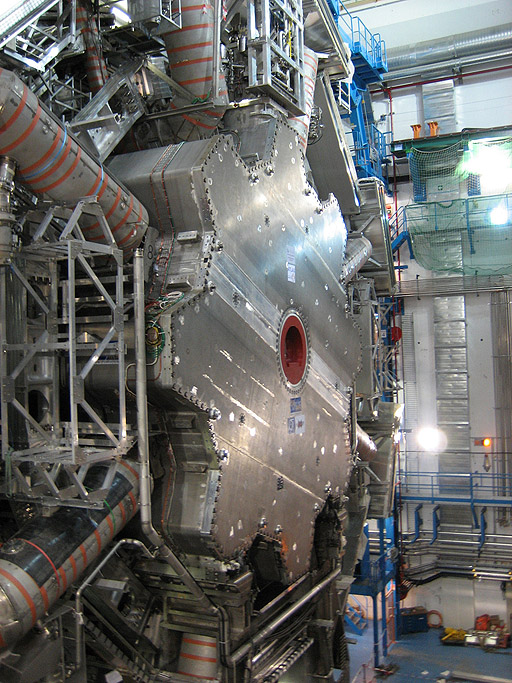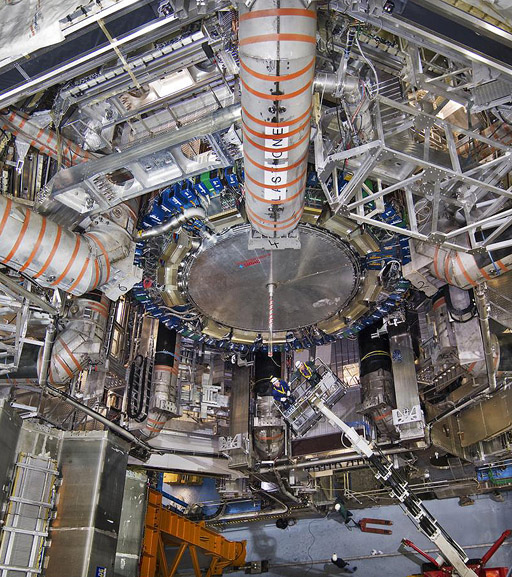 "QUANTUM SHOT" #389 "QUANTUM SHOT" #389link UPDATE, September 10, 2008: The first beam was fired on the LHC last night, and it went all the way around the circle. So far everything's great, but the Collider does not go full power till next year. When we needed a headline to spotlight this in DRB, we wrote down "LHC Goes Live! Titanic Possibilities" - but then looked at it again and scratched out heads. See if you can catch the irony. Look closely. This is what the world's first Time Machine may look like Never heard of "traversable wormholes?" Well, soon you might start hearing about them, as the world's most powerful particle accelerator becomes functional this spring - unleashing forces, capable of distorting not only space (just like gravity distorts space around Earth), but also TIME.  (image courtesy/copyright CERN) CERN's Large Hadron Collider is set to become the very first time machine in history. According to the research published by Irina Arefieva and Igor Volovich, "in general relativity, a time-like curve in space-time will run from past to future. But in some space-times the curves can intersect themselves, giving a closed-like curve, which is interpreted as a time machine - which suggests the possibility of time travel"  Two proton beams travel in opposite directions and collide at four points along the way - replicating the Big Bang conditions of "cosmic plasma", a mysterious almost liquid state, which occurred before quarks had cooled off enough to allow atoms to form together. The Large Hadron Collider will force quarks to break free of their bonds, the matter substance to unravel - to recreate the original "cosmic plasma", and to reconstruct Big Bang conditions. (hopefully on a much smaller scale)  (image courtesy/copyright CERN) Here are some quick facts: - 20-year work-in-progress - A team of 7,000 physicists from more than 80 nations - 27 kilometers in circumference, 175 meters underground - facilitating head-on collision of protons, traveling very near the speed-of-light - each tunnel is big enough to run a train through it. - temperatures generated: more than 1000,000 times hotter than the sun's core - superconducting magnets are cooled to a temperature colder than in deep space  (image credit: wiki - via) The Collider Tunnel:  (image courtesy/copyright CERN)  (click to enlarge; image courtesy/copyright CERN)  (image credit: David Levin) The most complicated thing that humans have ever built To better appreciate the enormous scale of this beast, consider that it runs 17 miles across the border of two countries, has detectors in four locations the size of buildings, housed in huge caverns - and if you happen to be inside the tunnel while this thing is in operation, you would have a highly radioactive - and fatal - experience. Just one superconducting solenoid (CMS) contains in it more iron than the Eiffel Tower. The cost of building LHC is so high, that America had to put a stop to its own Superconducting Super Collider in 1993 (even though 14 miles of tunnel had already been dug in Texas), so today CERN's structure is the lone contender for the title "the most complicated thing that humans have ever built".  (Installation of the CMS silicon tracking detector, photo by Michael Hoch, CERN)  (The world's largest solenoid magnet will be fitted inside, photo by Peter Ginter, CERN) Click on the image below to get a 360 degrees VR view:  (image credit: Peter McCready)  (image credit: Peter McCready)  (image credit: David Levin) CMS detector, before it was lowered 100m underground:  (image credit: Ryuji Kusumoto) Cross section of the ATLAS detector, the size of a cathedral:  (image credit: David Levin) There are people in these pictures, for scale (see if you can spot them):  (image courtesy/copyright CERN)  (image credit: David Levin) The wire bundles (seriously gnarly stuff):  (image credit: Robert Scoble) The LHC team has been called the "Lords of the Ring", the project itself compared to something out of Star Wars (hopefully not the building of the Death Star). Look at the picture below, doesn't it look like Han Solo's hyperdrive on the left?  (image courtesy/copyright CERN) The idea is to focus all this incredible energy into the smallest space possible. As they say, "the more energy goes in, the more massive the particles that come out". How massive? How about a miniature black hole? If not time-travel, other exciting thing produced by LHC may be: The end of the world as we know it Apologies for a sensationalist headline, but how would you like a miniature Big Bang generated in your community, with scientists going around in little black vans with blaring loudspeakers: "Everything is under control, remain calm, look for a miniature blackhole in your kitchen sink"? All jokes aside, scientists do expect excitement, but of the containable kind. The well-known reasons behind building LHC are finding the "God Particle" (Higgs Boson?) and coming up with the "Grand Unified Theory" of all forces of the Universe. For the estimation of dangers associated with LHC, read this paper abstract. All other weird notions that LHC may produce uncontrollable Medium-sized Bang, or a bad-mannered black hole, are put to rest by CERN scientists: they assure us that "even if black holes will be produced, they will be too small and too short-lived to generate a strong gravitational force." In other words, Geneva is not going to get sucked into anything cosmologically weird. Good. The Internet's Web started here... Time Travel might as well start here, too CERN scientists know what they talk about, and we can trust them - after all, last time they needed something for sharing collider data, they invented the World Wide Web! According to some sources, even now one THIRD of ALL internet traffic flows thru this facility in CERN's computing center (one of the three main hubs for world wide web):  (image credit: David Levin) I like how Discover Magazine puts it: "The collisions at LHC could spray out strange new kinds of matter, unfurl hidden dimensions of space, even generate tiny glowing reenactments of the birth of the universe." And now, as we have seen - it may even facilitate time travel. "We don’t even know what to expect," says French physicist Yves Schutz. "We’re now in a domain of energy that nobody has ever explored." Click to enlarge:  (image courtesy/copyright CERN) Particle Art for the Dawning Era In addition to everything else, the collision of particles makes for an interesting art: "Simulated Bubble Chamber"  (image credit: Eric Charlton) Read more: 1, 2, 3 See the huge depository of project's photos here, and full VR here Article by Avi Abrams, images by exclusive permission of CERN. All rights reserved Also read "Big Bang v2.0" Guaranteed 1Y0-A05 preparation by actual test through use of latest 83-640 dumps and 642-524 practice exam! Permanent Link...  ...+StumbleUpon ...+StumbleUpon  ...+Facebook ...+Facebook Related Posts: Tesla Power in your Backyard, How to become a cyborg |
Time Machine: CERN's Large Hadron Collider
Subscribe to:
Post Comments (Atom)
Check out this stream
Blog Archive
-
▼
2008
(968)
-
▼
March
(70)
- Link Latte 54
- Link Latte 54
- Disturbing Wiring, Part 4
- Disturbing Wiring, Part 4
- Orbit Wheel Skates
- Orbit Wheel Skates
- Russian Nuclear Icebreakers: to the North Pole!
- Russian Nuclear Icebreakers: to the North Pole!
- Job Market 2009
- Job Market 2009
- The Deadliest Creatures (Most Easy to Miss)
- The Deadliest Creatures (Most Easy to Miss)
- Subliminal Advertising
- Subliminal Advertising
- Strangest Christian Products and Signs
- Strangest Christian Products and Signs
- Link Latte 53
- Link Latte 53
- Lovely Ladies of Yesteryear, Part 2
- Lovely Ladies of Yesteryear, Part 2
- Shanty Town Car Chase
- Shanty Town Car Chase
- Fear & Loathing Inside Abandoned Stalin's Mines
- Fear & Loathing Inside Abandoned Stalin's Mines
- Flash Mob Musical
- Flash Mob Musical
- Armenia: The Epic Land
- Armenia: The Epic Land
- Big Bang, v2.0
- Big Bang, v2.0
- Time Machine: CERN's Large Hadron Collider
- Time Machine: CERN's Large Hadron Collider
- Link Latte 52
- Link Latte 52
- Airplane Oops! Situations, Part 2
- Airplane Oops! Situations, Part 2
- Rubik's Super Cubes
- Rubik's Super Cubes
- Surreal Art Update
- Surreal Art Update
- Zooffice!
- Zooffice!
- Funny Animals, Part 10
- Funny Animals, Part 10
- Twining Motion of Vines
- Twining Motion of Vines
- World's Worst Intersections & Traffic Jams
- World's Worst Intersections & Traffic Jams
- Link Latte 51
- Link Latte 51
- Radical Mannequins
- Radical Mannequins
- Onboard Rally Cam
- Onboard Rally Cam
- Police Can Be Intense (Funny Pics)
- Police Can Be Intense (Funny Pics)
- Vinyl Killer
- Vinyl Killer
- Airship Dreams
- Airship Dreams
- Don't Fight Monday!
- Don't Fight Monday!
- It's a Guy Thing! - Part 6
- It's a Guy Thing! - Part 6
- Extreme Weather
- Extreme Weather
- Link Latte 50
- Link Latte 50
- Archive: February 2008
- Archive: February 2008
-
▼
March
(70)







0 comments:
Post a Comment